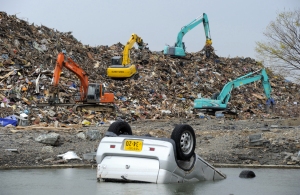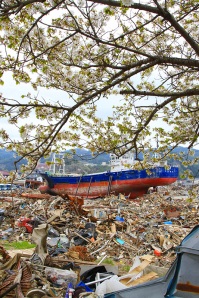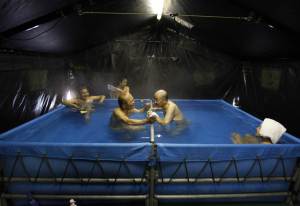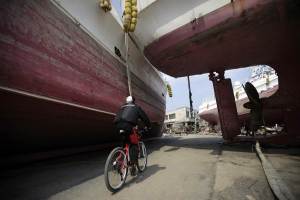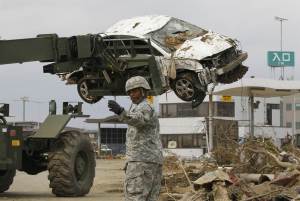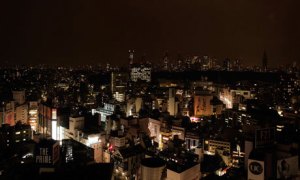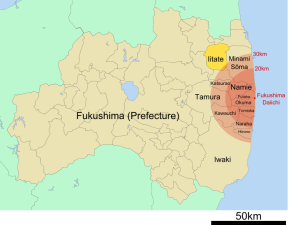While I’ve been busy teaching children to wrestle with nouns, verbs and adjectives (if you can recognize them, you’ve won the fight), history has been in the making in Tokyo. For weeks, I’ve been following friends’ accounts of the Friday evening anti-nuke demonstrations outside the Prime Minister’s residence in Kasumigaseki, and wishing desperately that I could join them. Kasumigaseki is a full two hours away from my station, Shibusawa; making the commitment to go would mean canceling classes for the entire day at my English cram school, necessitating apologies, explanations, and full refunds for the day’s lost lesson. In addition, I’d face the disapproval of my in-laws, my staff, and a large roomful of irate mothers. Although the demonstrations in Tokyo have now been officially labelled “Revolution” by the Japanese media, mothers of my students would be unimpressed by my throwing responsibility to the wind and charging off to Kasumigaseki. In a matter of time, I would be out of work. Many of my students, however, would think my actions were “kakko ii” (cool! awesome! whatever young people in the US say now. da bomb??). I do not know if this would be enough consolation for the loss of income. I guess you can tell by now that this will be an unusually personal blog post.
So, let me continue. In desperation (as I said), I stooped so low as to beg my husband to attend the demo in my stead. Knowing exactly what his answer would be even as I began my plea bargaining, I swallowed hard and used my persuasive powers. “Your field is
International Political Science! ” (this is true), and “How can you not go?? All your colleagues will be there!” (not true, and we both know it), and “You’re really going to get on the train and leave Tokyo just when all the action’s starting??” (he works in the heart of the city and hates all the hubbub. Of course he’s going to get out of town before a demo) . So, as I knew from the onset, it was all in vain. There is no budging a very stubborn academic, although I was bound to give it a shot. I am not one to bribe or blackmail, so when persuasion fails, I let things be.
It pains me to admit that I was not present at this past Friday’s massive demonstration (attendance estimated at between 40 to 50, ooo people). Indeed, I have not been to a single one of the Friday protests. I have been sending telepathic messages in the vague direction of Tokyo for months on end: “PLEEEASE HOLD YOUR PROTESTS ON DAYS THAT ARE CONVENIENT FOR ME. ALSO, NO EARLY MORNING MARCHES. (respectfully yours, etc.) ” This method has actually been partly successful, and I have been able to attend several good-sized demonstrations without sacrificing a work day. The Friday demos, however, did not change to Saturday no matter how hard I willed them to. And so, in lieu of my actual attendance, I will write about the build-up to the demo, the demo itself, and a bit about my own family’s response.
Friday night protests had been going on for months although, as one commentator on EX-SKF’s blog admitted, at first the action seemed more symbolic than influential. Slowly but surely, however, attendance began growing, though there was no advertisement other than Twitter, Facebook posts, and group emails. I believe the steady increase in popularity of the demos stemmed from the recent (and continuing) string of disappointments and betrayals felt by citizens across the country. Particularly painful was the recent rejection–no, the refusal to even consider–of a literal truckload of papers containing the signatures of Tokyo citizens demanding a

The governor of Tokyo, behaving badly. I hope his mother is no longer around to see this. (photo by Sumio Kanematsu)
referendum on nuclear power. Volunteers had collected 320,000 signatures ( “It was easy,” one of the signature-gathering volunteers told me during a visit to the anti-nuclear tents in Kasumigaseki. “I had no trouble getting people to sign. ” ) and presented them to the Tokyo Metropolitan Assembly on June 20th. The citizen representatives were met with rudeness and rejection. The rejection for their referendum request was by a 2-1 margin, and the rudeness was from Tokyo’s Mayor, Shintaro Ishihara, who made the thumbs-down sign to spectators gathered to witness the event. Having taught English in this country for thirteen years, I know that this means more than “no”. My students informed me straight off the bat in those first few months that it’s the equivalent of “Shinei!” or “You die!” Seeing the shock on students’ faces whenever I used this simple gesture, I very quickly learned to strike it from my repertoire. Ishihara-san, knowing full-well the implications of the gesture, did not hesitate to use it in public. Shame on you, cantankerous old man!
There was bad feeling all around, as the citizen representatives complained of being dismissed too easily, and of presenting their case to a group of officials who had already made up their minds to reject the proposal long beforehand. Which is probably true.
Tokyo officials, on the other hand, complained of “rowdy” spectators preventing them from doing business properly. No comment there from me; I have yet to witness even a speck of “rowdiness” as I define it (unruliness, destruction of public property, deliberate acts of violence, etc.) at any of the rallies or protests I have attended in the past year. On the contrary, folks seem almost unnaturally well-behaved and peaceful. Someone inside the assembly building must’ve shouted an anti-nuclear slogan or something?
The attempt to hold a citizen’s referendum on nuclear power in Tokyo clearly failed. Several months earlier, a similar attempt had been made in Osaka; that attempt also ended in failure. But the biggest setback of all was the central government’s decision to re-start two reactors at the Oi Nuclear Power Plant in Fukui Prefecture. The decision came suddenly, and was met with shock and disbelief by a majority of citizens who were ready to battle the summer heat without relying on nuclear power. As William Pesek states in a Bloomberg news article, “When more than two-thirds of the people in a democracy of 126 million are against something, a leader might bother to listen. That’s how many Japanese want the reactors to remain offline. Noda ignored that increasingly vocal majority and cleared two reactors at Kansai Electric Power Co.’s Ohi nuclear plant to reopen.”
This Mainichi Shinbun article also details the fuss that ensued, and readers can easily imagine the feelings of anger and betrayal felt by not just ordinary Japanese citizens, but by officials of nearby cities whose future would be at stake in case of an accident. Local officials in Oi City, however, agreed to the re-start. Hear what correspondant Justin McCurry has to say about their entanglement in the “Nuclear Power Money Tree” in this Christian Science Monitor article.

Buddhist monks engaging in prayer and fasting outside the entrance to Oi Nuclear Power Plant (photo from Kiyoshi Inoue’s album).
The Japan Times directly opposed the re-start in a an editorial piece entitled Regrettable “go” on Reactors, making the point that the Prime Minister and his team would have done better to come up with a plan of action well beforehand to ensure that the energy supply would be sufficient during the summer months , with or without nuclear power. Businesses and individuals have been more than willing to cooperate since last year’s disaster, and not taking advantage of the chance to implement lifestyle changes and seriously reduce energy use is “mottanai” (a wasted opportunity). As an example of the kind of changes hoped for by the Japan Times editor, my father-in-law recently attended a neighborhood meeting about reducing energy consumption in the summer months. This prompted him to call the electric company and arrange to reduce the maximum amount of electricity we can actually use (from 50 amps to 40) without experiencing a power failure. This basically means we cannot run five air conditioners at one time in the house….as if this frugal family would ever dream of such a thing! We will be saving money each month, and the country will save resources as well. “If everyone did this, there’d be plenty of electricity to go around all year long,” said the wise Grampa Iida. The JT editors also mention the enormity of the risk involved in this decision, as no-one truly believes the Oi reactors are completely disaster-proof, and the nuclear safety watchdog committee proposed by the government is not yet a reality.

Mainichi Shinbun photo of the June 22 demo outside the Prime Minister’s residence. That’s a lot of people in a very small space!
In the end, the hasty announcement of the re-starting of reactors at the Oi plant was probably the straw that broke the camel’s back. This past Friday, June 22nd, saw the Kasumigaseki district overwhelmed with protestors. And this time, the major Japanese mainstream media were there, from Asahi Shinbun to the Mainichi Daily News. There were interviews with individuals and live footage from the street; one reporter even ventured into the government building where officials were attempting to work. The noisy din from outside had penetrated through to interior (EX-SKF describes it as “deafening”), and the Prime Minister could not have been a happy camper. The reporter attempted to get a reaction from both the Minister of the Environment and the Minister of Economy, Trade and Industry, both of whom were at a loss for words. There are many official and non-official versions of the event, but I always enjoy EX-SKF, so here’s his report.
The demo made the NHK news at 10:00 on Friday night–a rather long segment devoted to the demo and the anti-nuclear movement–and I grinned in astonishment as I whacked my unsuspecting husband. “Look! There you are! I told you so: you missed history! You could’ve BEEN there!” And, for the first time, he did not huff in dismissal or make light of the situation. My friend Kimiko said it was the same with her husband. And my guess is that the mainstream media coverage probably tipped the scales in our favor for other dubious husbands as well. It’s hard not to let out a satisfying cry of, “Woo-hooo!” , and so I will allow myself to do so, once (there–it’s over and done with) . For over a full year now, I have attempted to refrain from the use of slang expressions, curse words (that’s an easy one, actually), or excessive !!!! (that one’s not so easy) in the interest of being taken seriously, so I feel a certain reward is long overdue. !!!!
Thank you for indulging me, and now back to business.
I did not hear the term “Hydrangea Revolution” until this morning, when I opened up facebook to find a post from Jacinta, along with her own beautiful photographs of hydrangeas taken in her neighborhood. After reading that one post, the phrase seemed to pop up repeatedly, all day long. The Friday demonstrations have been compared to the big, bold, brazen blooms ( are they not? nothing wimpy about hydrangeas) that are made up of myriads of tiny blossoms pressed together. What began as a series of small symbolic gatherings has become a huge, spirited protest that the media can no longer ignore. Make no mistake: there is much work yet to be done, and on the surface, nothing has changed. Still, people who were once thought of as embarrassments to society have now gained a measure of respect. With that respect will come increased power and influence. So I must remember that the revolution is not about me, and swallow my disappointment at not being part of the Friday demonstrations that led to the big event. And I must also send out a heartfelt thanks to those friends that did participate (Jacinta! Angela! Izumi! Scott! Sumiko?). Nice work! I haven’t made it to Tokyo on a Friday yet, but I’m proud to be on the same side as such good people. I’m part of the big, brazen bloom….Woo-hooooo!












































